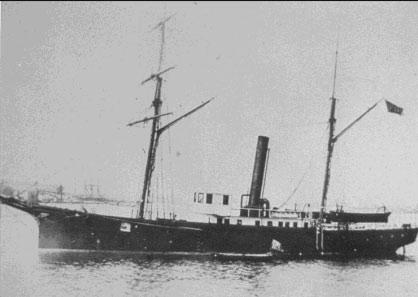BUAR classifies certain shipwrecks and other underwater archaeological resources as "Exempted Sites" for a variety of reasons, including (but not limited to): commonly known location, previous salvage, recreational value, educational value, or lack of significant archaeological or historical value. Recreational diving activities on these sites, including casual artifact collection, do not require a BUAR permit. However, any major disruption of the site is prohibited. The intent of creating an exempted shipwreck site is to preserve such sites for the continued enjoyment of the recreational diving community, who is encouraged to protect these sites for the continued enjoyment of all.
Note: All dives are conducted at your own risk. The Commonwealth of Massachusetts accepts no responsibility for loss of any kind, including personal injury or property damage. The Commonwealth of Massachusetts assumes no liability for inaccuracies in dive information contained in these pages including site locations and dive conditions.
Vessel Details
Description: Iron-hulled, U.S. Revenue Cutter.
Dimensions: Length 142 ft., width 23 ft., depth 9 ft.
Tonnage: Gross 250, other displacement - 210.
Propulsion: Primary - steam, single propeller; secondary - topsail schooner rig.
Machinery: 2 cylinder compound steam engine (1887) received new boiler in New York.
Cargo: Not applicable.
The Shipwreck
Date Sunk: January 6, 1892.
Cause: Stranded.
Location: Off the North Western side of Boo Hoo Ledge, Manchester-by-the-Sea.
Coordinates: Latitude 42° 33' 50" N; Longitude 70° 44' 52" W.
On the morning of the 6th of January 1892, the sky was overcast but visibility was good as the Albert Gallatin prepared to leave Kittery, Maine, en route to Provincetown, Massachusetts. Two of its complement of seven officers were missing, otherwise it was just another of hundreds of patrols she had made on her station between Portsmouth, New Hampshire and Holmes Hole, Massachusetts.
At 8:50 a.m., on a southerly course, the Albert Gallatin passed the Salvages, a cluster of ledges off Cape Ann. At 9:55 a.m. the weather became thick and soon thereafter snow began to fall. Intending to make the safety of Gloucester before visibility deteriorated, the steamer's course was changed. At 11:00 a.m. land was sighted, the engines stopped and a sounding of 12 fathoms taken. The pilot, thinking he was off Kettle Bottom Island, made a course change due East for Eastern Point. However, it was here that a mistake was made. What the pilot thought was Kettle Bottom Island was in fact Great Egg Rock. At 11:15 a.m. the cutter struck hard on Boo Hoo Ledge. All attempts to free the vessel were in vain. Soon, pounding seas carried away its skylights and it began to fill with water. As the vessel rolled, its smokestack toppled to starboard striking the ships Carpenter, Mr. J. Jacobson, killing him instantly.
Captain Gabrielson ordered his men to the lifeboats and all remaining hands got off without incident, making landfall in a rocky cove at Eagle Head. By 4:30 p.m., the storm had subsided sufficiently to see that the vessel had broken in two and was completely submerged.
Dive Site Conditions
Depth in feet: maximum 50, minimum 10.
Visibility in feet: average 25.
Salvage attempts have reduced the steamer's hull to little more than scattered frames and plates over broken ledge, crevices and rocks. As with all New England dive sites, visibility is a tricky subject, however most reports indicate no more than 30 feet at this site on a good day. The amount of algae growth will be dependent upon the time of year and the amount of sea urchins. New England's Legacy of Shipwrecks, (Keatts 1988), reports the wreckage free of growth, in effect an urchin barren. However, it's unknown whether this observation still applies.
Historical Background
Constructed: 1871, at Buffalo, NY. by David Bell.
Construction details: Iron hull, mahogany decks.
Crew: 39; Master: Capt. Eric Gabrielson.
Owners: United States Revenue Cutter Service.
Home or Hailing Port: Boston, Massachusetts.
Former Name(s) and date(s):
Official number: Country: U.S.A.
Other Comments: Armed with 2, 6 pound, brass "Whitworth" carriage guns, mounted in a broadside; Cruising Grounds - From Portsmouth, NH to Holmes Hole, MA. (Nov. - Dec. 1881) $10,000 overhaul.
The Albert Gallatin was considered one of the United States Revenue Cutter Service's most able seagoing vessels. During its career, it saved at least $50,000,000 worth of shipping from total destruction. Captain Gabrielson served in the Spanish American War as a volunteer naval officer. He commanded the Revenue Cutter Dexter when that vessel went to the aid of the City of Columbus which wrecked January 18, 1884 off Gay Head, Martha's Vineyard, Massachusetts, with the loss of 99 lives, most of whom were women and children.
The Gallatin was the first Revenue Cutter lost since the end of the Spanish American War.
Salvage
The February 27, 1892 edition of the New York Times reported the Government preparing to investigate charges of fraud in connection with the sale of the wreck for salvage. "Among the bids received were two reporting to be from the same firm." One of which was the highest of all. Notice was sent of its acceptance to which their reply stated that if such a bid had been received then it was a forgery. A Nova Scotia wrecking company, the existence of which could not be confirmed, reportedly made the next highest bid followed by that of the first wrecking company. However, subsequent reports state that two months after the sinking, the Collector of Customs at Boston transferred title of the Albert Gallatin to three Boston men, who intended to salvage it. Prior to the disaster, the steamer had been valued at $50,000. The winning bid was $679.
Sources
MBUAR File Number MA-8237;
New York Times 1/ 7/1892; New York Times 2/27/1892
New England's Legacy of Shipwrecks, Keatts, 1988;
Merchant Vessels of the United States, 1877
